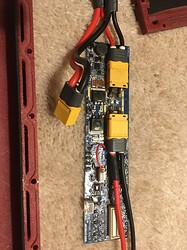So I went ahead and tried adding the diode. I was not able to get it to work but I learned a lot. I am going to move on to a smarter BMS so I have better control and more functionality. But I will unload what I learned in case someone wants to take it further.
I believe there are differences between generations of FM BMS. Earlier BMS like the 4206, and maybe the 4208, and 4209 +XR have more integration with the controller than the later 4210, 4211, 4212 +XR and pint BMS. This is because they moved the charge port from the controller to BMS for the pint model. To reduce the number of inventory parts FM probably chose to make the same change to the XR BMS that they executed for the pint.
Here is a 4206
Here is a newer model (unknown).
You will notice that there are some missing elements on the 4206 around the center of the board where the pint charger would connect to the board.
Without these elements to reduce the charge voltage, the voltage delivered to the BMS is higher than the BMS expects. This makes it overshoot. Once a cell hits 4.2V the BMS will shut off current flow between the XT connectors. What is supposed to happen is as it approaches the charge voltage, the current is reduced from 3.1A to .2A, but since the charge voltage is too high, current never reduces. This reduction in current is what allows the BMS to balance so it will not balance.
I was on the right track but I don’t think my part selection was exactly right. What you need is a simple circuit that reduces the charge voltage from 63.3 to about 62.0 at 3.1A. From there, as the battery approaches the charge voltage the circuit should reduce the voltage from 63.3 to about 62.7-62.9 at .2A. This will allow for a slower approach to max voltage and enable balancing.

